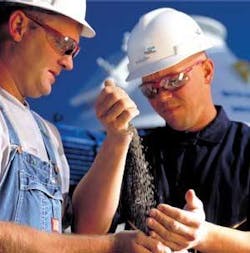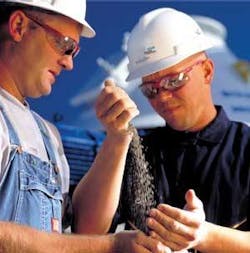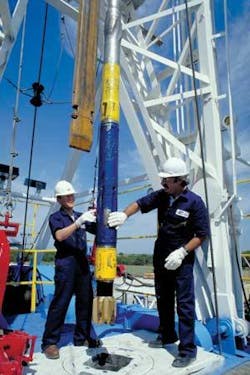When people think of the oil and natural gas industry, many envision an old, dirty, staid industry using technology from decades ago. The images they see on television or in the movies show oil gushing madly out of a well or drilling rig with a few men in dirty clothes throwing a chain around a drill pipe. Most people do not realize how outdated these images are.
Oil and gas is a very technology-dependent industry; many techniques developed by the industry are now used in other industries, including the space program. In fact, techniques used to produce oil and gas on the ocean floor have been compared to those used to land a rocket on another planet. Technological innovations have made it possible for the oil and gas industry to supply the fuels that power the world economy.
The development and application of advanced technology is vital to the modern industry task of finding and developing oil and gas resources. The reservoirs are covered with thousands of feet of rock, which makes it difficult to “see” the deposits. But the development of three-dimensional (3D) seismic coupled with significant increases in computational power allow the industry to develop fairly accurate models of the subsurface.
While these models can be viewed on a desktop computer, others are viewed in huge theaters with curved screens that can be used to project images in three dimensions. These 3D visualization centers allow technical personnel to see into the subsurface and explore what is there. This technology has enabled the industry to improve its success rate, meaning that reserves are found with fewer wells, less waste and less surface disturbance.
New and better technology has made it possible for the industry to economically develop large oil and gas deposits offshore. Drilling oil and gas wells in thousands of feet of water adds significantly to the complexity, cost and potential risks. However, technological innovations have enabled the industry to overcome the added challenges. Wells are routinely drilled in 5,000 feet or more (1,525 meters) of water depth, and in 2003, a well was drilled in the Gulf of Mexico in more than 10,000 feet (3,050 meters) of water. After penetrating the sea floor, these well bores extend thousands of feet below the ocean floor.
Such wells are drilled from a ship that uses dynamic-positioning technology. A series of small thrusters, combined with global positioning system (GPS) technology, allow the ship to remain essentially stable despite wind and water currents - shifting less than 50 feet in any direction. This stability allows the ship to drill in very deep water and in most weather conditions.
Offshore platforms are very expensive to build and install. The technology that goes into designing these structures, building them in a shipyard and then transporting and installing them, is significant. But if every offshore field required a platform, many offshore resources would be uneconomic to develop, so technology has been developed to place some of the equipment for producing oil or gas on the seabed. The produced fluids are piped to a nearby platform for processing. These subsea completions are maintained by underwater vehicles called remotely operated vehicles, or ROVs, that are operated by a worker on the platform nearby.
Advanced technology is also essential to the development of resources in remote and environmentally sensitive locations, such as the Arctic. The exploration phase of development (seismic, exploratory drilling) is conducted during the winter months to minimize disturbance to the environment and wildlife. Ice roads and drilling pads are constructed for use in these operations.
When spring arrives, the ice melts, leaving little or no trace of the operations. If oil or gas is found, technology has made it possible for the operations to have a very small “footprint.” Newer Arctic developments use less than 40 percent of the space that was required to develop Alaska’s Prudhoe Bay field. A new type of drilling platform was tested during early 2003 that raises drilling activities above the tundra, with only the support legs contacting the surface, further reducing potential impact.
Innovations in technology are expanding the depth horizons for exploration. Subsurface temperatures and pressures increase with depth, so that a depth is eventually reached that is beyond the capabilities of conventional equipment. But industry has worked diligently to develop equipment made from space-age titanium alloys that can withstand the high temperatures and high pressures (HT/HP) in very deep wells. The electronics needed to guide drilling operations and provide feedback on what is encountered downhole have been insulated to withstand HT/HP. As a result of these innovations, the industry now can develop fields with temperatures of 400° F (204° C) and pressures of 16,000 psi (11,000 N/cm2).
Technology allows the industry to get more oil or gas out of each deposit that it finds. Newer stimulation technologies, treatment fluids and enhanced recovery techniques enable the oil or gas to move more easily to producing wells. Hydraulic fracturing techniques create small cracks from the wellbore into the reservoir rock. These fractures serve as a “highway” for the hydrocarbons to reach producing wells. Horizontal-drilling technologies allow a reservoir to be penetrated horizontally rather than vertically, opening more of the reservoir to the well and enhancing recovery.
Technology has enhanced environmental protection as well. Directional drilling provides greatly increased flexibility in well placement, so that a well can be placed in the area where it will have the least possible environmental effect and still reach a reservoir that might be miles away laterally. Several wells can be drilled from a single location, dramatically decreasing the amount of land surface area required to develop a field.
Newer synthetic-based drilling fluids have been developed for applications that previously required oil-based fluids, reducing toxicity, oil usage and oily wastes that must be disposed of. Coiled-tubing drilling units are smaller, use less space, create less visual disturbance, make less noise, use less energy and reduce waste volumes. When offshore platforms have reached the end of their useful life, they may be removed for recycling or appropriate disposal, or they may be relocated for beneficial use as artificial reefs. These artificial reefs expand valuable fish habitats in areas lacking natural reefs, such as the Gulf of Mexico and offshore Thailand.
Technological innovation has been the hallmark of the petroleum industry from its earliest days. Petroleum engineers and geologists are constantly challenged to learn more about where oil and gas are found, how to get the rocks to give up the hydrocarbons they contain, how to get the oil or gas out of the ground efficiently, and how to do all of it while minimizing environmental impacts. An important part of the mission of the Society of Petroleum Engineers is to assist the industry in this process through the collection and dissemination of technical information. By learning what others have done successfully, or even tried and failed, engineers are empowered to make the next technological breakthrough that will continue to improve the industry’s ability to produce the oil and gas that the world needs.
* Information courtesy of the Society of Petroleum Engineers


